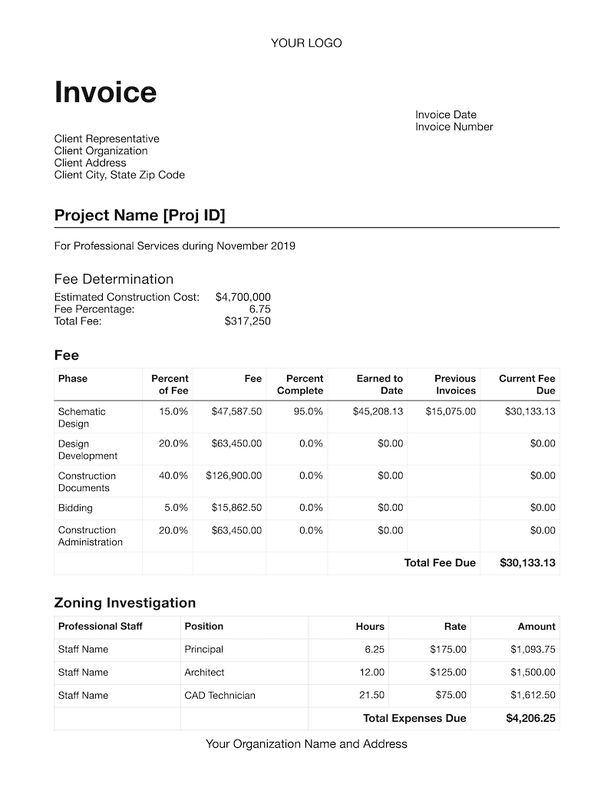|
The most important things about invoices. The most important things in no particular order: timing, simplicity of content, ease of execution, one or two recipients, the dun, initial payment, online payment TIMING The best time period to invoice for is twice monthly. Since that doubles the work for the same result, invoice monthly. You have probably noticed that the rest of the business world operates on a monthly basis. You should too. You have just spent a month working on a project. How long should you wait to send the bill? The correct answer is no time at all. Send it on the first business day of the following month. If you think this is impossible, either your invoicing process is too complicated, or your invoicing process needs some careful thought. Or the damn timesheets need to be turned in daily before leaving work, but that is another topic. SIMPLICITY OF CONTENT Here is the simplest of content for an invoice: “There is now due $xxxx.” The ONLY problem with this solution is that clients come in different flavors. This is fine for some. For others, no amount of detail is too much. You cannot afford to waste the time that the ‘hungry for details’ client wants. What you can afford to do is attach a printout of all the time expended. Keep it simple.
When a client wants elaborate breakdown on each invoice, you should get something in return. I suggest that you demand immediate payment into your bank upon receipt. Depending on the economy and the client’s financial circumstances, the demand for detail may just be a delaying tactic. The point is that if you have a business relationship, then both parties have to agree. EASE OF EXECUTION
To get invoices out on the first business day of the new month is the goal. You can do it, but the key to achieving the goal is that it has to be easy. The only way that it can be easy is if all the timesheets are automatically collated for you. That, in turn, requires all time entries to be made directly into a database. The database can tell you how much of each phase has been spent for fixed fee projects or how much to charge for the work on each phase of hourly fee projects. All that remains is for you to fill in the values on an invoice template, decide if it feels ‘right’, and make a PDF to send. If it isn’t this easy, start making the changes that will make it this easy. ONE OR TWO RECIPIENTS One recipient of your invoice is usually fine. It is good to ask “Who else?” We once had a really good client. They were a public corporation. Our ‘boss’ was a senior VP. Nobody liked bothering him. So we bugged accounting directly. They had never seen the invoice, but they had a solution - always send them a copy. They didn’t mind getting approval to pay. Our rule became ‘always send invoices to our ‘boss’ and also to whoever makes the payments’. THE DUN For most clients ten days is about right for payment. Boards and committees and governments may need to approve payment at a monthly meeting, but they should make payment a day or so later. Corporations may have an accounts payable cycle that affects your invoice. Whatever the situation, you should make it clear that you expect payment on time. After all, you have paid labor and expenses on their behalf. Send a ‘due now’ notice on the morning that the payment is due. Send a late notice every few days. Be a pest until the client gets you taken care of. In cases where payments will consistently be made 30 days or more after the work is complete make sure that you are being compensated for the delay. This is easier said than done. You can always include a late payments clause (subject to any usury laws) and show it on the next invoice. You may not get paid for lateness, but it is business-like to act like payments are important and your work is important. In extreme unexplained delays, stop working on the project. Developers have a reputation for not paying because they are gambling. Don’t let them ruin your business, too. INITIAL PAYMENT One way to deal with late or consistently delayed payments is to get ahead of the curve with an initial payment. This is also a good tactic to use with ‘sketchy’ clients. My recommendation is to make the initial payment the minimum due under the contract and set its value to about one month’s work. I would make it a separate phase: Initial Payment and Project Mobilization. The logistics of an initial payment for an Hourly Rates job make it awkward to use. Make it a lump sum, perhaps a few hundred dollars, that stands alone - not related to hourly rates. For a fixed fee, deduct the initial payment from the last phase. Then proceed as usual. ONLINE PAYMENT Match your client’s skill level. If they can make online payments, you need to be ready to receive them. You get paid faster, and spend less time babysitting payments. I found that all of these issues can be implemented with almost zero pushback. It is really up to you. Comments are closed.
|
x
Archives
February 2024
Categories
All
|
Architekwiki | Architect's Resource | Greater Cincinnati
© 2012-2022 Architekwiki
© 2012-2022 Architekwiki








